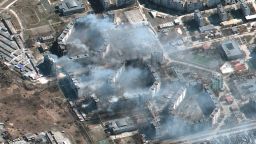Russia has used hypersonic missiles in its invasion of Ukraine, US President Joe Biden confirmed Monday.
“And if you’ll notice, (Russia has) just launched the hypersonic missile, because it’s the only thing that they can get through with absolute certainty,” Biden said. “It’s a consequential weapon … it’s almost impossible to stop it. There’s a reason they’re using it.”
Pentagon spokesperson John Kirby said during a news briefing on Tuesday that Russian forces used hypersonic missiles “at least in one instance,” that the US is aware of. Russian forces used the hypersonic missile “against a fixed building,” at a “relatively close range,” Kirby said.
Despite the Biden’s comments, British intelligence and even the US President’s own defense secretary have downplayed Russia’s use of its air-launched Kinzhal missiles.
“I would not see it as a game changer,” Pentagon chief Lloyd Austin told CBS’ “Face the Nation.”
And the UK Defense Ministry said the Kinzhal missile is really just an air-launched version of the Iskander short-range ballistic missile (SRBM), which Russia has used repeatedly in its invasion of Ukraine.
Why the fear and hype about hypersonic missiles? First, it’s important to understand the term.
Essentially, all missiles are hypersonic — which means they travel at least five times the speed of sound. Almost any warhead released from a rocket miles in the atmosphere will reach this speed heading to its target. It is not a new technology.
What military powers — including Russia, China, the United States and North Korea – are working on now is a hypersonic glide vehicle (HGV). An HGV is a highly maneuverable payload that can theoretically fly at hypersonic speed while adjusting course and altitude to fly under radar detection and around missile defenses.
An HGV is the weapon that’s almost impossible to stop. And Russia is thought to have an HGV in its arsenal, the Avangard system, which Russian President Vladimir Putin in 2018 called “practically invulnerable” to Western air defenses.
But the Kinzhal, as a variant of the Iskander SRBM, is not an HGV. While it does have limited maneuverability like the Iskander, its main advantage is that it can be launched from MiG-31 fighter jets, giving it a longer range and the ability to attack from multiple directions, according to a report last year from the Center for Strategic and International Studies.
“The MiG-31K can strike from unpredictable directions and could avoid interception attempts altogether. The flying carrier vehicle might also be more survivable than the road-mobile Iskander system,” the report said.
The same report also noted that the ground-launched Iskander proved vulnerable to missile defense systems during the 2020 Nagorno-Karabakh war, during which Azeri forces intercepted an Armenian Iskander.
“This suggests that claims of the Kinzhal’s invulnerability to missile defense systems may also be somewhat exaggerated,” the report said.
Read more here.




























































